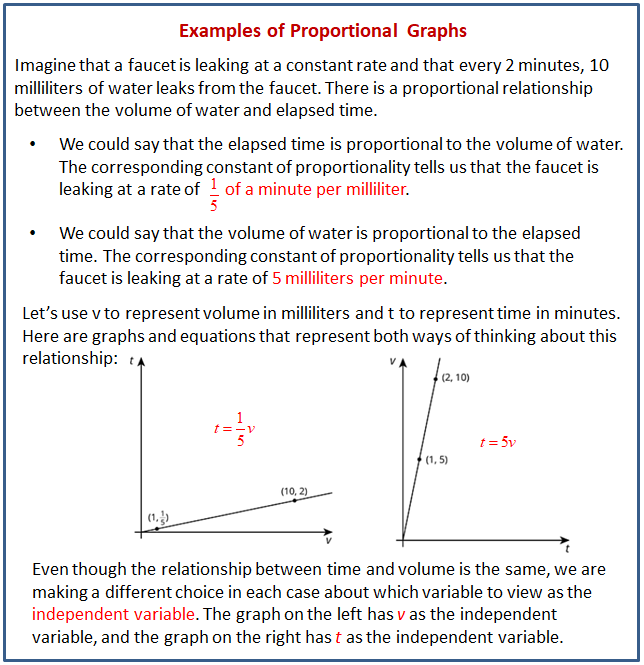Illustrative Mathematics Grade 7, Unit 2, Lesson 13: Two Graphs for Each Relationship
Learning Targets:
- I can interpret a graph of a proportional relationship using the situation.
- I can write an equation representing a proportional relationship from a graph.
Related Pages
Illustrative Math
Grade 7
Lesson 13: Two Graphs for Each Relationship
Let’s graph more than one relationship on the same grid.
Illustrative Math Unit 7.2, Lesson 13 (printable worksheets)
Lesson 13 Summary
The following diagram shows how to interpret a graph of a proportional relationship using the situation and write an equation representing the proportional relationship.

Lesson 13.1 True or False: Fractions and Decimals
Decide whether each equation is true or false. Be prepared to explain your reasoning.
- 3/2 · 16 = 3 · 8
- 3/4 ÷ 1/2 = 6/4 ÷ 1/4
- (2.8) · (1.3) = (0.7)(52)
Lesson 13.2 Tables, Graphs, and Equations
Explore the graph. Notice the values in the table and the coordinates of the labeled point. Grab the point and move it around.
- What stays the same and what changes in the table? in the equation? on the graph?
Open Applet - Choose one row in the table and write it here. To what does this row correspond on the graph?
Grab and drag the point until you see the equation y = 3/2 x. - Do not move the point. Choose three rows from the table, other than the origin. Record x and y, and compute y/x.
- What do you notice? What does this have to do with the equation of the line?
- Do not move the point. Check the box to view the coordinates (1,?). What are the coordinates of this point? What does this correspond to in the table? What does this correspond to in the equation?
- Drag the point to a different location. Record the equation of the line, the coordinates of three points, and the value of y/x.
- Based on your observations, summarize any connections you see between the table, characteristics of the graph, and the equation.
Are you ready for more?
The graph of an equation of the form y = kx, where k is a positive number, is a line through (0,0) and the point (1,k).
- Name at least one line through (0,0) that cannot be represented by an equation like this.
-
Show Answer
When k is negative.
-
Show Answer
- If you could draw the graphs of all of the equations of this form in the same coordinate plane, what would it look like?
-
Show Answer
The graphs will fill up quadrant I and quadrant III
-
Show Answer
Lesson 13.3 Hot Dog Eating Contest
Andre and Jada were in a hot dog eating contest. Andre ate 10 hot dogs in 3 minutes. Jada ate 12 hot dogs in 5 minutes.
- The points shown on the first set of axes display information about Andre’s and Jada’s consumption. Which point indicates Andre’s consumption? Which indicates Jada’s consumption? Label them.
Open Applet - Draw two lines: one through the origin and Andre’s point, and one through the origin and Jada’s point. Write an equation for each line. Use t to represent time in minutes, and h to represent number of hot dogs.
- What does the constant of proportionality tell you in each case?
- The points shown on the second set of axes display information about Andre’s and Jada’s consumption. Which point indicates Andre’s consumption? Which indicates Jada’s consumption? Label them.
Open Applet - Draw lines from the origin through each of the two points. Write an equation for each line. What does the constant of proportionality tell you in each case?
Lesson 13 Practice Problems
- At the supermarket you can fill your own honey bear container. A customer buys 12 oz of honey for $5.40.
a. How much does honey cost per ounce?
b. How much honey can you buy per dollar?
c. Write two different equations that represent this situation. Use h for ounces of honey and c for cost in dollars.
d. Choose one of your equations, and sketch its graph. Be sure to label the axes. - The point (3, 6/5) lies on the graph representing a proportional relationship. Which of the following points also lie on the same graph? Select all that apply.
A. (1, 0.4)
B. (1.5, 6/10)
C. (6/5, 3)
D. (4, 11/5)
E. (15, 6) - A trail mix recipe asks for 4 cups of raisins for every 6 cups of peanuts. There is a proportional relationship between the amount of raisins, r (cups), and the amount of peanuts, p (cups), in this recipe.
a. Write the equation for the relationship that has constant of proportionality greater than 1. Graph the relationship.
b. Write the equation for the relationship that has constant of proportionality less than 1. Graph the relationship. - Here is a graph that represents a proportional relationship.
a. Come up with a situation that could be represented by this graph.
b. Label the axes with the quantities in your situation.
c. Give the graph a title.
d. Choose a point on the graph. What do the coordinates represent in your situation?
The Open Up Resources math curriculum is free to download from the Open Up Resources website and is also available from Illustrative Mathematics.
Try out our new and fun Fraction Concoction Game.
Add and subtract fractions to make exciting fraction concoctions following a recipe. There are four levels of difficulty: Easy, medium, hard and insane. Practice the basics of fraction addition and subtraction or challenge yourself with the insane level.

We welcome your feedback, comments and questions about this site or page. Please submit your feedback or enquiries via our Feedback page.